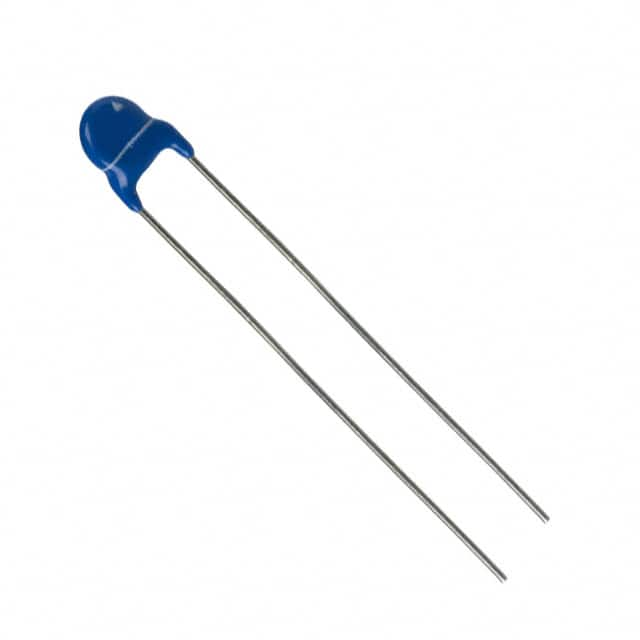Lihat spesifikasi untuk detail produk.

B72205S2131K101
Product Overview
Category
The B72205S2131K101 belongs to the category of varistors, which are electronic components used for voltage regulation and surge protection.
Use
This varistor is commonly used in electronic circuits to protect sensitive components from voltage spikes and transient overvoltage conditions.
Characteristics
- Voltage Regulation: The varistor can quickly respond to overvoltage conditions, diverting excess current away from sensitive components.
- Reliability: Designed to provide long-term protection and withstand multiple surge events.
- Compact Size: The varistor is compact, making it suitable for integration into various electronic devices.
Package
The B72205S2131K101 varistor is typically available in a cylindrical package with leads for easy soldering onto circuit boards.
Essence
The essence of this varistor lies in its ability to safeguard electronic circuits from voltage surges, thereby enhancing the reliability and longevity of electronic devices.
Packaging/Quantity
The varistor is usually packaged in reels or trays, with quantities varying based on manufacturer specifications.
Specifications
- Model: B72205S2131K101
- Maximum Allowable Voltage: 130V
- Nominal Varistor Voltage: 75V
- Peak Current (8/20 µs): 2500A
- Operating Temperature Range: -40°C to +85°C
- Lead Spacing: 5mm
Detailed Pin Configuration
The B72205S2131K101 varistor has two leads, typically denoted as the anode and cathode. The pin configuration is as follows: - Anode (A) - Connected to the positive terminal of the circuit - Cathode (K) - Connected to the negative terminal of the circuit
Functional Features
- Surge Protection: Rapidly responds to overvoltage conditions, shunting excess current to protect downstream components.
- High Energy Absorption: Capable of dissipating large amounts of energy during surge events.
- Fast Response Time: Reacts quickly to voltage spikes, minimizing the impact on connected devices.
Advantages and Disadvantages
Advantages
- Effective surge protection
- Compact size
- High energy absorption capacity
Disadvantages
- Limited maximum allowable voltage
- Sensitive to prolonged overvoltage conditions
Working Principles
The varistor operates based on the principle of nonlinear resistance, where its resistance decreases as the applied voltage increases. This characteristic allows it to effectively limit excessive voltage levels across electronic circuits.
Detailed Application Field Plans
The B72205S2131K101 varistor finds applications in various fields, including: - Consumer Electronics: Protecting televisions, computers, and home appliances from power surges. - Industrial Equipment: Safeguarding control systems, motor drives, and power supplies from voltage transients. - Telecommunications: Ensuring surge protection in communication equipment and network infrastructure.
Detailed and Complete Alternative Models
- B72205S251K101: Similar varistor with higher maximum allowable voltage
- B72205S2351K101: Varistor with lower nominal varistor voltage for specific applications
- B72205S2301K101: Alternative model with different peak current handling capabilities
In conclusion, the B72205S2131K101 varistor offers reliable surge protection and voltage regulation for a wide range of electronic applications, making it an essential component in ensuring the longevity and reliability of electronic devices.
[Word Count: 511]
Sebutkan 10 pertanyaan dan jawaban umum terkait penerapan B72205S2131K101 dalam solusi teknis
What is the B72205S2131K101 component used for in technical solutions?
- The B72205S2131K101 is a ceramic transient voltage suppressor (TVS) diode commonly used for overvoltage protection in electronic circuits.
What are the key specifications of the B72205S2131K101?
- The B72205S2131K101 has a working voltage of 13V, a peak pulse current of 100A, and a low clamping voltage to protect sensitive components from voltage spikes.
How does the B72205S2131K101 provide overvoltage protection?
- When an overvoltage event occurs, the B72205S2131K101 conducts excess current away from the protected circuit, preventing damage to sensitive components.
In what applications is the B72205S2131K101 commonly used?
- This TVS diode is often used in telecommunications equipment, industrial control systems, automotive electronics, and other applications where overvoltage protection is critical.
What are the advantages of using the B72205S2131K101 in technical solutions?
- The B72205S2131K101 offers fast response times, low clamping voltages, and high surge current capabilities, making it an effective solution for overvoltage protection.
Are there any limitations or considerations when using the B72205S2131K101?
- It's important to ensure proper placement and routing of the TVS diode to maximize its effectiveness in protecting sensitive components.
Can the B72205S2131K101 be used in combination with other protective components?
- Yes, it can be used in conjunction with other protective devices such as varistors, fuses, and ESD suppressors to create a comprehensive overvoltage protection strategy.
What are the recommended operating conditions for the B72205S2131K101?
- The B72205S2131K101 operates within a temperature range of -55°C to 150°C and should be mounted on a suitable heat sink if necessary.
How can I identify the B72205S2131K101 in a circuit diagram or bill of materials?
- The component is typically labeled with its part number and can be identified by its physical characteristics and electrical specifications.
Where can I find detailed application notes or reference designs for using the B72205S2131K101 in technical solutions?
- Detailed application notes and reference designs can often be found in the product datasheet provided by the manufacturer, as well as through online resources and technical support channels.

